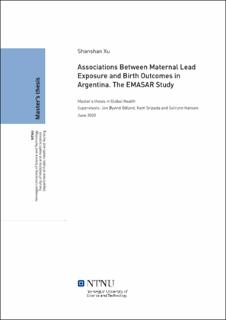| dc.description.abstract | Background: The EMASAR assessed concentrations of environmental toxins in the blood of
delivering women to investigate maternal and fetal health risks related to food security and
exposure to persistent toxic substances in two regions of Argentina (Ushuaia and Salta).
Objectives: To determine the blood lead levels and identify related risk factors among
delivering women in Argentina and to evaluate the relationships between maternal lead
exposure and birth outcomes.
Methods: Blood samples derived from EMASAR study were analyzed. A total of 696
maternal serum samples collected from Ushuaia (n = 198) and Salta (n = 498) singleton
women at 36±12 hours after delivery. Data of health and sociodemographic characteristics of
the mother and their child were obtained from the medical records and questionnaires.
Multiple linear regression models were applied to describe the relationships between lead
exposure and related maternal risk factors, as well as the associations between levels of
maternal blood lead and birth outcomes while adjusting for the possible confounders and
covariates. Adjusted logistic regression analyses were used to examine the relationships
between quartile of maternal blood lead levels and preterm birth, and low birth weight.
Results: Blood lead levels were higher in women from Salta than those in Ushuaia (p < 0.001),
with geometric mean blood lead levels of 15.8 μg/L and 10.1 μg/L, respectively. The geographic
differences in blood lead levels can be explained by the differences in socioeconomic conditions,
prior or current industry emissions and potential contributors of regional pollution. Age and
smoking were positively associated with the blood lead levels. Women with primary education
had significant higher levels of lead in serum than those who attended tertiary education. Blood
lead levels were higher in women in urban areas than in those that live in rural areas. Adjusted
models of multiple linear regression analyses suggested that increasing blood lead levels were
related to increase in the gestational age in the overall sample. Significant negative associations
were found between blood lead levels and birth weight, and birth length in the Salta sample.
No significant associations between lead exposure and birth outcomes were observed in the
Ushuaia sample. There were no clear relationships between quartile of blood lead levels and
preterm birth or low birth weight were evident in the adjusted logistic regression models.
Conclusions: Maternal lead exposure was mainly related with residence, age, smoking and
education. Blood lead levels showed a positive association with gestational age in the overall
sample. Inversely, even maternal low-level lead exposure may adversely affect birth weight
and birth length in the Salta sample. There was no evidence to suggest dose-response
relationships for the effect of blood lead levels on birth outcomes. Blood lead levels should be
kept as low as possible especially during pregnancy to minimize undesirable effects.
Keywords: EMASAR; Lead; Maternal serum; Risk factors; Birth outcomes; Argentina | |
